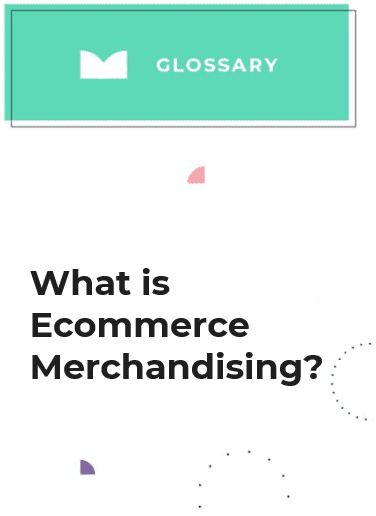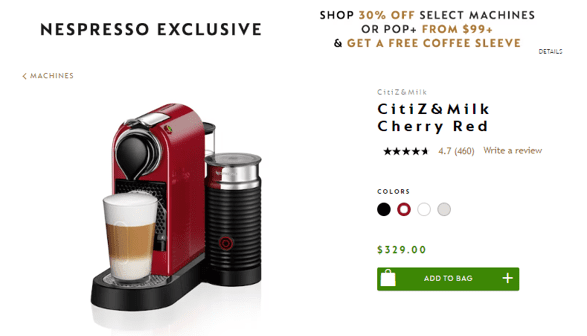
What is Ecommerce Merchandising?
Ecommerce merchandising is the strategic art of digitally showcasing and tailoring product presentations to convert the maximum number of potential customers. It mimics traditional retail merchandising in that it uses elements like white space, display/presentation, and visual cues to get website or app visitors into a “buying” mindset.
But unlike old-school merchandising, eCommerce or digital merchandising relies on virtual signals to capture shoppers’ attention. Carefully designed product pages, smart site navigation tools, clean page layouts and crisp images – these are the hooks that get people intrigued by a pair of sunglasses or an $500 cappuccino machine. Done well, eCommerce merchandising removes every possible friction point on the path from browsing to buying.
Ecommerce Merchandising Example
You know when you drop by a retailer’s website and there’s a 30% coupon enticing you? Or a picture of a coffee machine so clear and crisp that you can practically hear it percolating with fresh coffee through the screen?
When these visual cues are paired with personalized recommendations and content, shoppers become incredibly motivated to browse, buy, and discover new products. This is an example of effective eCommerce merchandising and Nespresso, a premium coffee brand known for its elite coffee machines and robust, flavorful coffee, does it exceptionally well.
Nespresso pairs digital merchandising techniques like compelling images and succinct descriptions with personalized content. They created a brief interactive Coffee Quiz to help website visitors discover their perfect coffee match. The quiz asks users three questions related to their coffee preferences. As a user answers the questions, they’re presented with detailed information about various Nespresso products they might like based on coffee intensity, various tasting notes (e.g., woody, berry), and other qualities.
Nespresso then integrates personalized product recommendations into the user’s browsing experience. They do this based on the quiz results, educating customers while guiding them towards coffees, recipes, and content tailored to their tastes.
The Nespresso website’s existing visuals, use of white space, navigational prompting, and straightforward layout, combined with this high-level of personalization, amounts to an exceptionally well-done digital merchandising approach.
Why is Ecommerce Merchandising Important?
Ecommerce merchandising makes the shopping experience more user friendly and allows retailers to customize and personalize the shopping experience without relying on third-party cookies or specific user data to deliver impactful content. Instead, you can target visitors using anonymized data and roll in personalized customer data, if the user opts into that.
Anonymizing data removes identifying information from data sets so that individuals can’t be identified. Some key data anonymization techniques like hashing, aggregation, and noise injection remove enough specificity from data to prevent connecting people to specific data points.
By analyzing aggregate browse and purchase behavior without collecting individual identifying information, you can uncover broader patterns that inform merchandising strategies.
This includes discovering customer segments with shared interests, identifying best-selling items to promote, and detecting associations between products that frequently get purchased together.
These anonymized insights then power personalized recommendations, tailored product bundles and displays of trending or related merchandise. So, rather than making assumptions, data-driven eCommerce merchandising allows retail websites to respond directly to how customers navigate and shop the inventory in the aggregate.
Benefits of eCommerce merchandising include:
- Increased product discoverability – Strategies like search optimization, filtering, and visual cues (buttons, colors, etc.) direct customers to the most relevant products quickly. This saves shoppers time while getting desired items in front of them fast.
- Enhanced storytelling and branding – Compelling descriptions, on-theme imagery and bundles enrich product narratives. This connects customers more emotionally to merchandise.
- Higher Conversions – Tactics like cross-selling, upselling and discounts incentivize customers to purchase more. Streamlined checkout also minimizes cart abandonment.
- Improved user experience – Personalized recommendations, strong design aesthetic (UI design), and intuitive navigation elements like an easy-to-locate search function reduce frustration and help customers feel “seen.”
- Actionable Insights – Performance analytics identify merchandising gaps and winning strategies. Teams can continuously refine tactics based on hard data.
What’s the Difference Between Traditional and Ecommerce Merchandising?
Traditional merchandising centers on physical stores, using in-person retail elements like display positioning, signage, and store layout to boost sales.
Ecommerce merchandising happens digitally within websites, apps, and online platforms. It relies on technology and data, leveraging tactics like targeted offers, AI-driven recommendations, and optimized product pages.
While traditional merchandising creates an appealing environment for in-store shoppers, eCommerce merchandising aims to enhance online shopping experiences. It personalizes browsing to match customer preferences and persuades with compelling visuals and copy.
Both boost sales, but eCommerce merchandising employs algorithms, analytics, and customization not possible in traditional brick-and-mortar merchandising. Its data and tech-driven approach optimizes conversions in the virtual space.
What are some Ecommerce Merchandising Best Practices?
Here are some best practices to consider when crafting an eCommerce merchandising strategy. These elements are important for improving the customer shopping experience and driving online sales:
- Make search super easy – This is crucial. Be sure your search bar is visible on every page. Include auto-complete suggestions as customers type so they find the right products faster. And optimize your product descriptions so the search results are populated with exact matches, if available, and similar products.
- Craft intuitive site navigation – Set up clear, logical categories and subcategories to guide customers to the right products. Add filters and sorting too, so they can refine what they’re looking for.
- Create customer segments – Group customers by their behaviors and purchase history. This allows you to showcase different products and offers tailored to those segments.
- Personalize content and recommendations – Use customer purchasing data and in-session browsing history to recommend complementary products, display related items, and customize the shopping experience.
- Optimize product pages – Have stellar images, descriptions, reviews, specs, and anything else shoppers need to make a confident purchase decision.
- Leverage reviews and social proof – Ratings, reviews and user content build trust and confidence to drive more sales. Elements like “trending now” and “X number of shoppers have items in cart” create a feeling of scarcity and FOMO.
- Make checkout seamless – Fast, painless, and intuitive checkout helps combat cart abandonment. So does offering multiple payment methods and things like Buy Now Pay Later.

How can Ecommerce Merchandising Tools Help Improve Your Business?
Ecommerce merchandising tools help you automate some of the best practices we listed above. You can curate products and facilitate creating product sets with software like Monetate’s dynamic bundling tool which uses AI to automatically pair complementary items together. For example, it might match sweaters with complimentary jewelry and accessories or jeans with Chelsea boots.
Automated product bundling makes it possible to assemble relevant (and compelling) product pairings based on customer profiles and browsing behavior. This would be difficult for even the savviest human merchandisers to accomplish manually at scale.
Online shoppers benefit from this approach by more easily finding products they may not already be aware of. Smart bundles promote product discovery by introducing related add-on items tailored to their unique tastes. This leads to a more curated, personalized shopping experience. It scratches that “I want to be seen” itch that we get when doing business with a retailer. This can translate to more supplemental purchases and increased average order values (AOVs.)
The result of impactful eCommerce merchandising is a smarter, more customer-focused online retail experience. Shoppers benefit from customized suggestions aligned to their needs, easier discovery of relevant items, and continually refined merchandising approaches based on what is resonating best with site visitors
